Abstract
There is much research looking at the negative aspects of media. There are studies addressing social concerns about the impact of media on how people define themselves, success, society, government and many other areas.
There has long been concern that a steady diet of negative news has contributed towards public disillusionment. Seeing images on the news night after night could lend itself to a learned world view far more negative than the world is in reality.
If this is true and negative media creates feelings of disillusionment and despair, then it would make sense that positive media should do the opposite-this was worth a try. Through research considering Interactive Documentary, Constructive/Solutions Journalism and Social Media, this paper looks at this idea.
Introduction
As media changes in the digital age, it is also important to look at story structure and how that is changing the ways in which stories are told. The shift in audience metrics from “exposure” to “engagement” offers important opportunities for makers to think about different ways of communicating a message. Different communication paths containing the message, or story, can be structured in what could be describe as “micro-narratives”—small narrative units that, like Legos, can be disaggregated and reconfigured in various ways (Uricchio,2015). This is where interactive documentary/storytelling come into play.
“If the growth of interactive documentary does anything, I think it will open our eyes to the hundreds of possibilities of telling stories in original ways, and re-defining what a story is, what an audience is, and what a maker is.” Gerry Flahive, National Film Board of Canada.
There are two journalism models considered for this research. Solutions journalism is a practice that looks at reporting on how people are doing better and adaptive responses that people can learn from. Constructive journalism is described by Seán Dagan Wood as “a publication that shines a light on innovation, kindness, co-operation and the ways people are working to create solutions to the problems facing society.” Both of these styles use positivity to increase reader engagement.
This research examines the idea that creating positive solutions-based digital stories can enhance the narrative for social awareness. This research was done using an interactive web-based project entitled Each Others Shoulders. These techniques can be used in many aspects of journalism and storytelling. Using digital and social media to enhance stories is becoming the norm. Organizations such as community journalism, collaborative media, participatory journalism, democratic journalism, street journalism and social change organizations can all benefit from this research.
The Project
The Each Others Shoulders interactive is a site about women. Women who have made the journey a little bit easier for others. It looks at the positive impact women have had on the world through the eyes of other women. Users are asked to “share a story” of a woman who made a difference in their lives. This can be someone they personally know or a historical or public figure who helped them be a better woman in some way.
Each Others Shoulders was initially set up on WordPress, a blog posting website This project began a few months prior to the first Women’s March on Washington, January 21, 2017. Although there was much negativity among women concerning the election of Donald Trump, this site dedicated to keeping the conversation positive.
As part of the project, open sourced, or approved existing video was re-edited to add to both the Inspirational Women and History sections of the project.
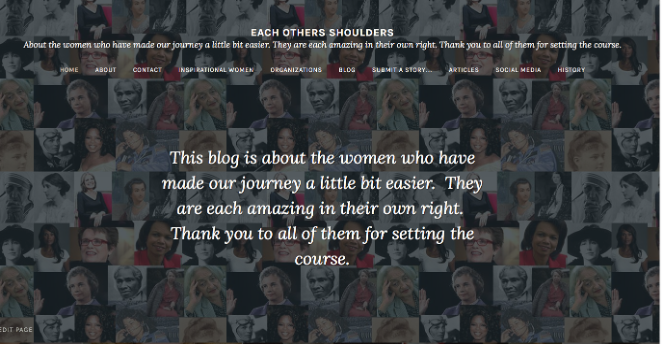
Methodology
A project was created to allow participants to share stories that would make a positive impact on a social cause. Social awareness is defined by the Collaborative for Academic, Social, and Emotional Learning as, “the ability to take the perspective of and empathize with others, including those from diverse backgrounds and cultures.” Although social awareness was the main goal of this experiment, social change was looked at as a mark of success. Social Change goes further in transforming a culture along with behaviors and social structure(Vago, 2004).
To best understand how to use digital media for social awareness the Ripple Strategies were used as a measurement. Ripple Strategies is a full-service communications agency that designs and implements media campaigns to accelerate positive social change (Ripple, 2018).
Ripple gives 3 suggestions to begin creating media for social change:
- Establish Authority:
- developing credible content- tell a good, true story
- fostering credible relationships- credible, relevant experts and trusted
- preparing credible responses- be proactive and to keep control of your messaging
- Ignite Conversations and Change:
- telling memorable stories
- AIDA conversion funnel, which shows the progression a person makes from initially hearing about an issue to taking-action. The conversion funnel involves four sequential steps: Awareness, Interest, Desire, and Action (AIDA).
- Measuring Impact
- Online Analytics
- Likes, Follows
Three areas of consideration were used for this project:
- Interactive documentary
- An interactive documentary, or multimedia documentary is a is considered non-fictional storytelling that not only uses video, audio, photographic, but also applies full complement of multimedia tools. These tools allow the user(watcher, listener, doer) to control or modify the journey as the go (Kim, 2014). This can happen in many ways; comment, like, share, add are all available in interactive documentary.
- Using:
- Unique and original footage
- Aggregated footage from the Women’s March on Washington and organizations
- Existing open-sourced media
- Participatory media
For a project to be considered an Interactive Documentary for Social Change it must create social awareness, civic engagement and ultimately social change.
- Constructive/Solutions Journalism
- Solutions journalism is an approach to news reporting that focuses on the responses to social issues as well as the problems themselves. Solutions stories, anchored in credible evidence, explain how and why responses are working, or not working. Constructive journalism works alongside Solutions Journalism using positive, solutions-focused storytelling for community engagement. These types of journalism were created in response to the increase in negative, tabloidism and fake news in the new media.
- Social Awareness through Social Media
- Social awareness, can be defined as consciousness shared by different individuals within a society. We will look at using social media to create awareness of the problems within a society or a community.
Objectives
The objectives are to use the tools of technology to; film and edit short, meaningful segments and aggregate already existing media, to create the story. The story will shed positive light on the social cause. This media will be shared through a social media campaign and interaction through blogging, to create an audience and effect social awareness.
With so much emphasis on the negativity in media, specifically when attached to social causes (Black Lives Matter, Trump Election) this paper will examine if positive interactive media alone can make a difference in creating social awareness.
This research considers the impact that positive interactive media combined with interactive documentary can create an awareness in a social justice situation. The objectives were to use the tools of technology to; film and edit short, meaningful segments and aggregate already existing media, to create the story. The story shed positive light on the social cause. This media was shared through a social media campaign and interaction through blogging, to create an audience and effect social awareness.
Analytics were used to measure citizen engagement in the cause and interaction data will be collected to determine social awareness and change.
This research worked around the experiment, Each Others Shoulders, an online interactive website which looked at the positive impact women have had on the world and share that as a way of advancing the cause.
Literature Review
“Interactive media/documentary/storytelling combined with the use of interactive and social media tools create the stage, audience and actors that are needed to bring about social awareness, engagement and change. In theory, if this is done in a positive way it will create an audience and interaction that is positive as well” (Cardillo, 2018). Interactive media/documentary is considered non-fictional storytelling that not only uses video, audio, photographic, but also applies full complement of multimedia tools. These tools allow the user (watcher, listener, doer) to control or modify the journey as the go (Kim, 2014).
This project combined Interactive documentary with Solutions/Constructive Journalism and Social Media to share a story and find results.
- The Interactive Documentary:
- Interactive and Cross-media innovations have created a new model of communication that can go in many directions, where audiences can both consume and produce in the social activist setting (Whiteman, 2003). By 2005, more possibilities grew for online participation. The introduction of peer-to-peer broadcasting, largely influenced by YouTube created ever-expanding possibilities for social networking and change. Sites like Facebook continue to add to social networking possibilities. Web 2.0 has created a truly unique opportunity to explore International communities (Miller, 2009).
New interactive tools allow the viewer to take on a collaborative role as creator. When the viewer is encouraged to add their voice to a project, it enhances the community and welcomes others to do the same. This type of interactivity allows the user to become intimately involved with the project and the social cause.
Documentary filmmakers have been producing commentaries concerning the world’s marginalized people and places in an effort to shed light on the problems and help create social movements to effect change for the future (Moyano, 2011). New technologies are now in place that can elevate this light to a much greater audience, through the use of interactive storytelling and multi-media platforms.
- Constructive/Solutiouns Journalism:
- Journalism today is so focused on highlighting problems; it often misses opportunities to tell the many stories about how society is responding effectively to those problems. Looking at the positive, solution-based side of the story can bring about forward moving conversation and involvement.
- Solutions Journalism:
- “Journalism’s historical approach is to spotlight social problems in order to spur reform, exposing wrongdoing or generating awareness — or outrage — about injustice, neglect or hidden threats. This “watchdog” role is critical to the vitality of democratic society. But we believe it’s also insufficient, because it fails to capture and circulate some of the most essential information that society needs to understand and solve its problems” (Reeves, 2017,1).
Constructive Journalism is a method of journalism that includes rigorous, compelling reporting that includes positive and solution-focused elements in order to empower audiences and present a fuller picture of truth, while upholding journalism’s core functions and ethics. Constructive Journalism was founded in 2014 by Sean Wood and Danielle Batista in London(Constructive Journalism Project, n.d.).
These types of journalism/storytelling can, not only, engage and empower people as consumers of media but, more importantly, as actors in the solutions.
The University of Pennsylvania did a study where they looked at several hundred New York Times articles to determine the type of news media consumers/users choose to share. The results were overwhelming in favor of positive news. The Times’ John Tierney, describing the research. “The more positive an article, the more likely it was to be shared” (Tierney, 2013).
- Social Media for Social Awareness:
According to Dovey (2014), the content of the blog world, Facebook, Twitter, Instagram or Flickr are all real, journalistic, and expressive and this is what interactive storytelling encompasses. These social media outlets are living documentaries for those who create them. New tools for collaboration and sharing in social media platforms build a participatory culture that creates the formation of groups with common views and goals (Jenkins 2006). (Social) media plays an important rold in molding society and spreading awareness in important events. It is the best tool for spearding social awareness(Dwivedi & Pandey, 2013).
Analysis
The project, Each Others Shoulders is an interactive site about women. The format was set up in the style of Interactive Documentary and used Solutions/Constructive Journalism techniques as a basis. Interactive Documentary uses short form(micro-documentary) clips to engage users to become involved with the cause. Each Others Shoulders invited users to upload video, still photos and written stories to the site in order to engage the audience. These additions also added to the story to make Each Others Shoulders a living document. Constructive/Solutions Journalsim was used by applying positive techniques to the process and production in an effort to create productive and engaging coverage.
Users are asked to “share a story” of a woman who made a positive difference in their lives. This can be someone they personally know or a historical or public figure who helped them be a better woman in some way.
The submission page states:
This is where Each Others Shoulders becomes an interactive, participatory, living documentary.
Please share a story about a woman who has influenced, inspired or changed you in some way. This woman can be someone you personally know who is not “famous”(or known to the rest of us-yet), or she can be an historical or public woman who inspires you.
Please share a story, a photo, a video or audio recording…anything that allows us to know this woman better. The more women we learn about the better we become. We stand on each others shoulders.
In order to create a simple way to collect the Submit a Story information, Wix.com was used to create a small website with the Grabimo application for story collection. “Grabimo is an application that allows you to collect, manage, and publish stories in multimedia format: Video, Audio, Photo, and Text” (Grabimo, 2018).
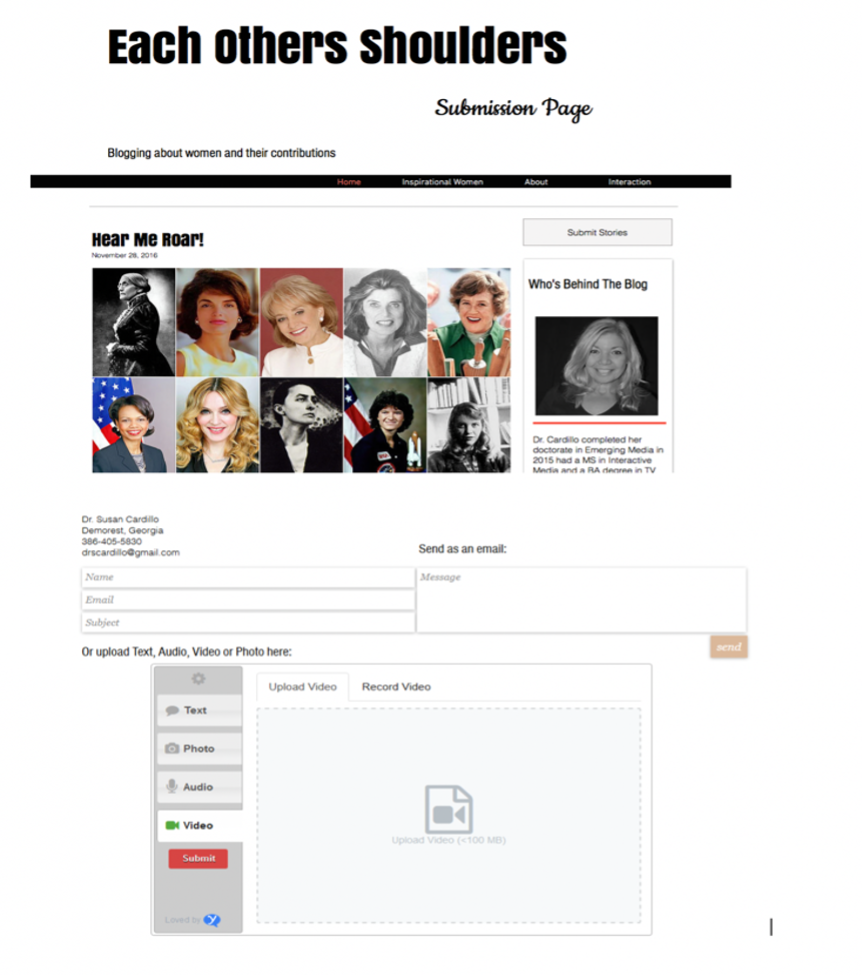
When considering the Ripple Strategies and social media for social awareness, there were three areas in the project where social media made a difference in awareness.
Establishing authority: the site, along with the Facebook page, was able to create credible content while fostering credible relationships. Great care was taken in preparing credible responses to comments and posts at all times. As this project started with the beginning of plans for the Women’s March and was quickly picked up and carried by those organizers, on their social media, there was immediate establishing of authority.
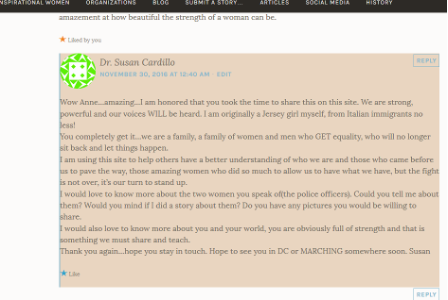
Igniting conversations: This was challenging at first. Getting people involved to submit stories and comments was the most difficult part. Likes, follows and shares were the most common with comments building as the March drew near. In the few weeks prior to the march, as women were preparing for their journey, the story and photo submissions began to upload. Also, during and soon after the march the site continued to get engagement. One issue that began to occur was that the “positive” nature of the conversation began to wane as the inauguration of Donald Trump coincided with the Women’s March. As we continued to only put out positive media the comments began to become more negative.
Measuring impact: This was done through analytics. An early post about the Women’s March on Washington entitled, “Why I Will March: A Bi-Partisan Approach received over 1500 hits and 130 shares in less than two weeks, using only Facebook as a channel. This remained consistent from late November until the end of January (the march was on January 21, 2017). The Women’s March organizers continued to share our posts and women continued to share their stories and photos. We received many photos and news stories on how women were preparing for the march. The march dominated the site. We continued to upload positive stories about women who were making a difference in the world but the uploads continued to center around the march, with a few exceptions of women who uploaded stories of female heroes in their lives.
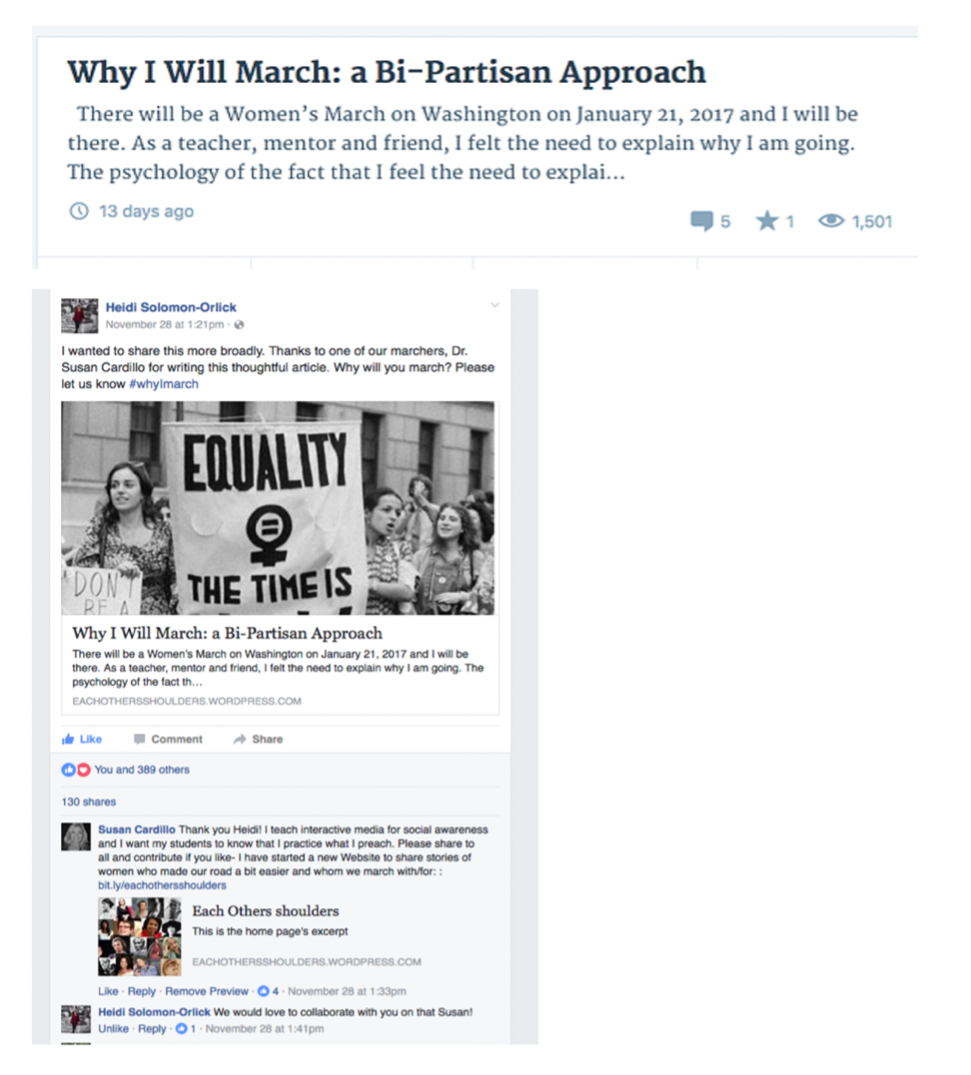
This project continued for a few months after the Women’s March on Washington and proceeded to create numbers in the analytics with user interested in the cause of women’s rights. In a matter of approximately four months’ time the site drew in 3634 views with 2743 visitors.
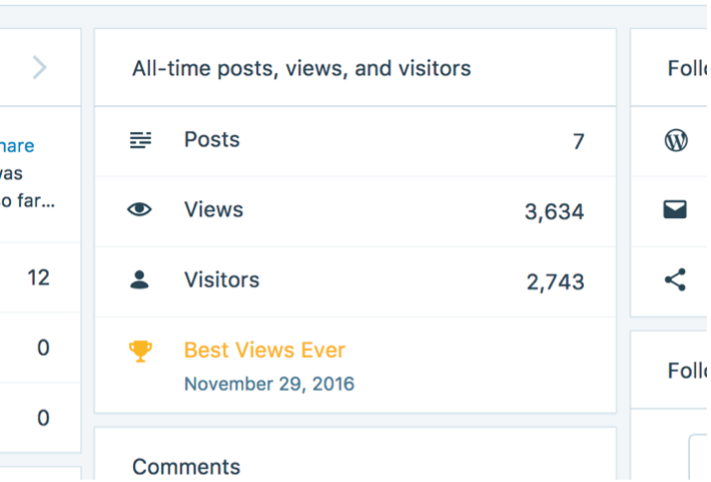
Facebook gave this project the biggest boost which funneled traffic to the Each Others Shoulders site.
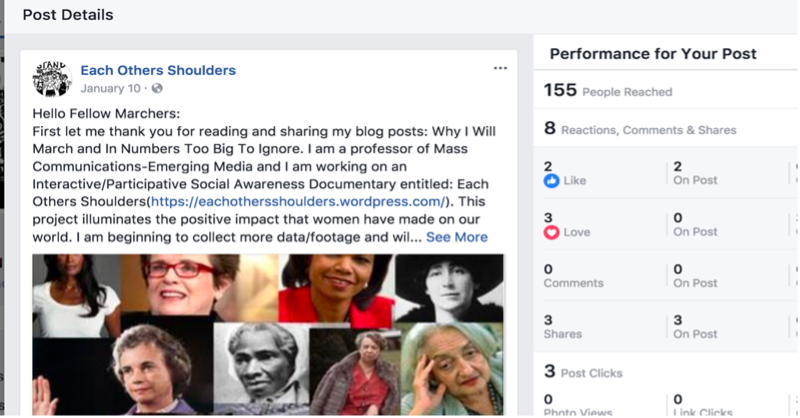
On Twitter we used the hashtag: #eachothersshoulders. Twitter worked well for story aggregation in that we could see who was using the hashtag and contact that user to get permission for their story and ask if they wanted to share.
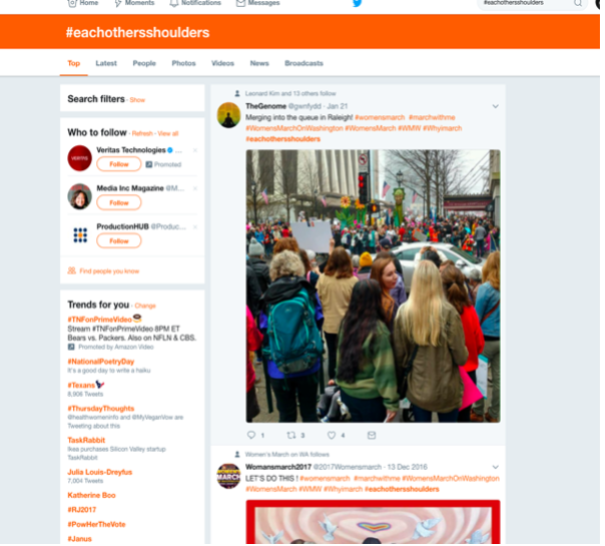
A digital mini-documentary narrative video was made and sent out through social media soon after the march in order to keep the conversation going. This surprisingly received little to know coverage. Once the march was over, although we continued to reach out on social media the interest waned. One hypothesis is that it was over three minutes and that is too long for social media users to decide to click on and stay. Also, the site had no immediate or long-term gratification.
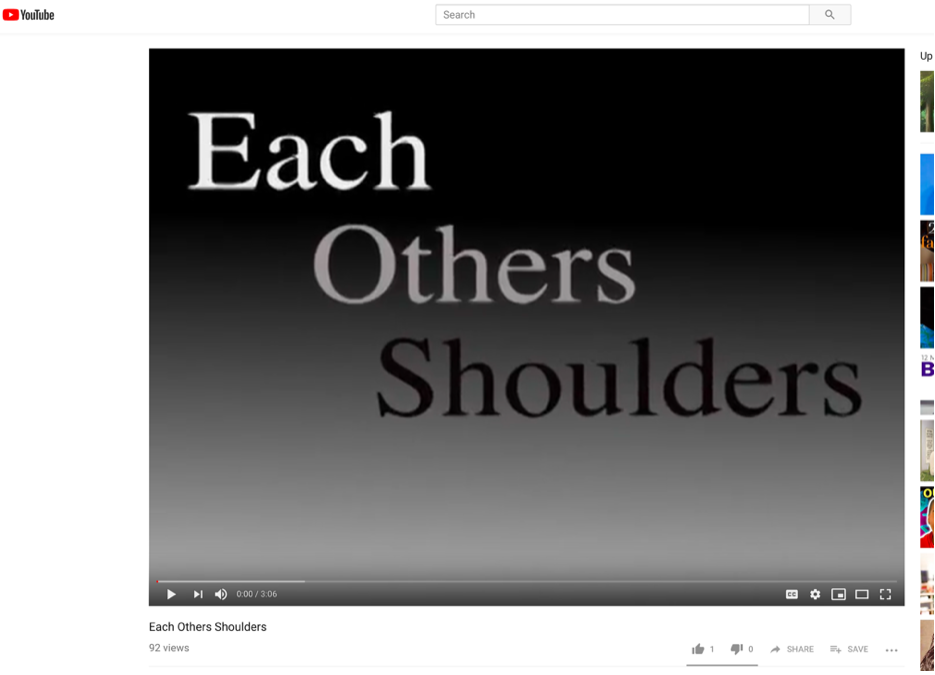
Is Social Awareness enough? Or does there need to be Social Change for success?
Results
Deciding to delineate this paper as Positive Solutions- Digital Media Storytelling for Social Awareness rather than committing to Social Change opened up many questions for this researcher. The thought process was to consider Positive Solutions Digital Media Storytelling in a way that it would begin a conversation that would help causes to make users more socially aware. The problem lies in how this plays out in social media and what success looks like.
Considering the idea that visuals help us to learn and act, along with constructive/solutions journalism and interactive documentary, this paper looked at how we can create a social change environment by creating a positive campaign and asking for interaction.
For the most part the campaign stayed positive, with the only negativity coming from user comments about the election of Donald Trump. The use of social media as a tool for social good has its strengths and challenges. The strengths are that if the message is both timely, short and conveniently placed it will get large numbers. But once the timeliness wares off there is little to no interaction, as there needs to be some kind of immediate gratification. The creator would need to continually work to keep the campaign alive in order to have consistent interaction.
Also, there is strong evidence that users prefer to like and share more than comment. And asking them to engage by adding content is difficult to achieve. More research is needed in the area of how to keep consistent engagement for causes. Although this site never asked for money, only time and effort, it was still difficult to get users to engage at that level. If a set of procedures could be developed that would help to prolong engagement, this would benefit all social causes in the future.
When creating an Interactive Documentary for Social Change project there are three things that need to occur:
- First the project must create social awareness, which this project did.
- Next the project must create civic engagement, which this project also did, to some extent.
- And the last piece to the puzzle is that the project needs to create social change.
Did change occur?
- This is the piece of the puzzle that will be looked at in future work.
- Does the cause campaign need to have a “finish” in order to be successful?
- Is the project a success because it made people stop and get involved or did there need to be a greater outcome in order for success to be apparent?
- What does change look like?
Conclusion
There is much research looking at the negative aspects of media. This paper looked at what might happen using Interactive Documentary, Constructive/Solutions Journalism and Social media to tell a positive story. Each Others Shoulders was able to create social engagement for a short time.
These techniques can be used in many aspects of journalism and storytelling. Using digital and social media to enhance stories is becoming the norm. Organizations such as community journalism, collaborative media, participatory journalism, democratic journalism, street journalism and social change organizations can all benefit from this research.
Now more research needs to be done to find out how to keep the audience and create social change. There are so many amazing causes in this world that people can become involved with, we just have to find ways, other than like, share and comment to get people to act.
References
- Cardillo, S. (2015). Interactive documentaries: Emerging technologies for social change (Order No. 3682111). ProQuest Central Essentials; ProQuest Dissertations & Theses Global: The Humanities and Social Sciences Collection. (1656502076).
- Cardillo, S. (2017). A Few Solutions for a New Time. Retrieved from: https://eachothersshoulders.wordpress.com/author/drsusancardillo/
- Cardillo, S. (2017). Media Technology and Justice: Teaching Interactive Storytelling for the Greater Good. Contemporary Issues Summit, Harvard, Boston, USA, March 2017, Vol 13, No. 1, ISSN: 2330-1236
- Collaborative for Academic, Social, and Emotional Learning (CASEL)Retrieved from https://casel.org/sel-framework/
- Constructive Journalism Project. (n.d.) Retrieved from https://www.constructivejournalism.org/
- Contemporary Issues Summit, Harvard, Boston, USA, March 2017, Vol. 13, No. 1 ISSN: 2330-1236
- Dovey, J. (2014) Documentary ecosystems: collaboration and exploitation. In Nash,
- K., Hight, C., & Summerhayes, C. (Eds.). (2014). New documentary ecologies: emerging platforms, practices and discourses. Palgrave Macmillan.
- Dwivedi, P. K., & Pandey, I. (2013). Role of media in social awareness. Humanities & Social Sciences Reviews, 1(1), 67-70.
- Grabimo. (2018) Retrieved from https://www.grabimo.com/
- Jenkins, H. (2006). Convergence culture: Where old and new media collide. NYU press.
- Kim, N. 2014. Interactive Documentary as a New Media. Retrieved from http://onlinepresent.org/proceedings/vol52_2014/21.pdf
- Meter, M. Minnaugh, J. (2010) Be Afraid, America. Be Very Afraid: The Effect of Negative Media. Retrieved from https://neuroanthropology.net/2010/04/25/be-afraid-america-be-very-afraid-the-effect-of-negative-media/
- Miller, E. (2009). Building participation in the outreach for the documentary The Water Front. Journal of Canadian Studies/Revue d’études canadiennes, 43(1), 59-86.
- Moyano, M. (2011). Documentaries for social change: an examination of Blooming Hope. St. Thomas University. Stanford Social Innovation Review, 1(1), 60.
- Norris, P. (2000) “A Virtuous Circle: Political Communications in Post-Industrial Societies.” NY: Cambridge University Press
- Reeves, C. (2007). News and the Negativity Bias? What the Research Says. Retrieved from https://thewholestory.solutionsjournalism.org/news-and-the-negativity-bias-what-the-research-says-78a0bca05b11
- Ripple Strategies. (2018). Retrieved from https://www.ripplestrategies.com/
- Samuels, S. and Turner.G (n.d.) How to Sue the Media for Social Change. Retrieved from http://www.ripplestrategies.com/use-media-social-change-report/
- Tierney, J. (2013). Good News Beats Bad on Social Networks. Retrieved from http://www.nytimes.com/2013/03/19/science/good-news-spreads-faster-on-twitter-and-facebook.html?_r=2&pagewanted=all&
- Whiteman, D. (2003). Reel impact: how nonprofits harness the power of documentary film
- Uricchio, W.(2015) Mapping The Intersection Of Two Cultures: Interactive Documentary And Digital Journalism
- Vago, S. (2004). Social change (5th ed.). Upper Saddle River, NJ: Prentice Hall.
About the Author
Dr. Susan Cardillo, Assistant Professor of Digital Media and Journalism at the University of Hartford focuses her tenure work on Interactive/Micro Documentary for Social Awareness and Change. She is currently in post-production with Campus ReBoot, a crowd-sourced, interactive and collaborative documentary about College during Covid19. She can be reached at [email protected]